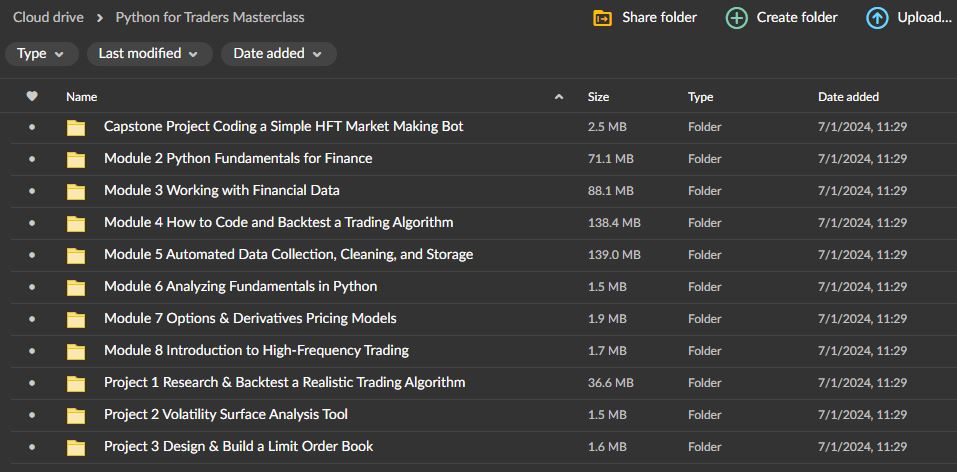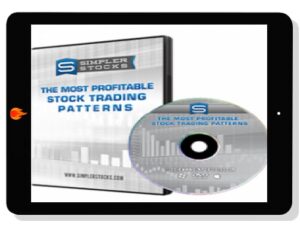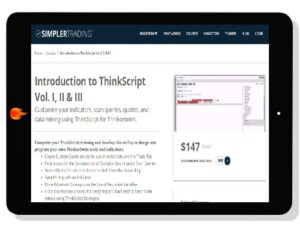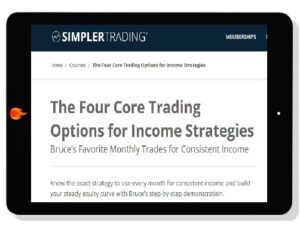Python for Traders Masterclass 2024
Python for Traders Masterclass 2024 course is now available at an affordable price. You can check out directly using multiple payment gateway options. If you have any questions or need an alternative payment method, feel free to contact us.
Description
Python for Traders Masterclass 2024 Download
Python for Traders Masterclass 2024 | Size: 484 MB
About Course:
The Python for Traders Masterclass
8 Modules
4 Projects
105 Lessons
248 Code Examples
34 Hours of Content
Module 1: Introduction
1.1. Welcome to the Python for Traders Masterclass(2:14)PREVIEW
1.2. Why learn to code as a trader?(7:15)PREVIEW
1.3. Why should traders learn Python?(4:23)PREVIEW
1.4. What will I gain from this course?PREVIEW
1.5. What topics will be covered?PREVIEW
1.6. Who is the intended audience for this course?PREVIEW
1.7. How much finance knowledge do I need?(1:40)PREVIEW
1.8. How much coding knowledge do I need?(1:37)PREVIEW
1.9. Placement Quiz: Am I a good fit for this course?PREVIEW
1.10. Module QuizSTART
Module 2: Python Fundamentals for Finance
2.1. Python Installation and SetupSTART
2.2. Running Python CodeSTART
2.3. Basic Python(26:34)START
2.4. Intermediate Python(5:07)START
2.5. Advanced PythonSTART
2.6. Data Science in PythonSTART
2.7. Key library: PandasSTART
2.8. Key library: NumPySTART
2.9. Key library: MatplotlibSTART
2.10. Key library: StatsmodelsSTART
2.11. Key library: Scikit-learnSTART
Module 3: Working with Financial Data
3.1. Introduction to Financial Data: Time Series and Cross-SectionsSTART
3.2. Data Acquisition and Cleaning(18:09)START
3.3. Time Series Analysis(13:38)START
3.4. Understanding Stationarity(11:55)START
3.5. Time Series ForecastingSTART
3.6. Exploratory Data AnalysisSTART
3.7. Section summarySTART
Module 4: How to Code and Backtest a Trading Algorithm
4.1. So what is a trading algorithm?START
4.2. Algorithm Design PrinciplesSTART
4.3. Data Management Module(15:12)START
4.4. Signal Generation Module(15:12)START
4.5. Risk Management Module(10:58)START
4.6. Trade Execution Module(10:27)START
4.7. Portfolio Management Module(11:05)START
4.8. Backtesting BasicsSTART
4.9. Backtesting SoftwareSTART
4.10. Advanced Backtesting TechniquesSTART
4.11. Optimization and Parameter TuningSTART
Project 1: Research & Backtest a Realistic Trading Algorithm
Project Overview(6:57)START
Step 1: Getting Started on QuantConnect(6:53)START
Step 2: Formulate a StrategySTART
Solution: Formulate a StrategySTART
Step 3: Develop the AlgorithmSTART
Solution: Develop the AlgorithmSTART
Step 4: Run a Backtesting AnalysisSTART
Solution 4: Run a Backtesting AnalysisSTART
Project SummarySTART
Module 5: Automated Data Collection, Cleaning, and Storage
5.1. Sourcing financial data(5:38)START
5.2. Working with CSVsSTART
5.3. Working with JSONSTART
5.4. Scraping data from APIs(51:35)START
5.5. Scraping data from websitesSTART
5.6. Persisting data: files and databasesSTART
5.7. Section summarySTART
Module 6: Analyzing Fundamentals in Python
6.1. Structured vs. Unstructured DataSTART
6.2. Types of Fundamental DataSTART
6.3. Gathering & Cleaning Fundamental DataSTART
6.4. Automated Screening & FilteringSTART
6.5. Statistical Analysis of Fundamental DataSTART
6.6. Natural Language Processing on News ArticlesSTART
6.7. Natural Language Processing on Annual ReportsSTART
6.8. Using LLMs for Natural Language ProcessingSTART
Module 7: Options & Derivatives Pricing Models
7.1. Introduction to Options & DerivativesSTART
7.2. Basics of Option PricingSTART
7.3. The Binomial Options Pricing ModelSTART
7.4. The Black-Scholes-Merton ModelSTART
7.5. Monte Carlo Simulation for Option PricingSTART
7.6. Introduction to Exotic OptionsSTART
7.7. Interest Rate Derivatives and Term StructureSTART
7.8. Implementing Finite Difference Methods for Option PricingSTART
7.9. Volatility and Implied VolatilitySTART
7.10. Advanced Topics and Modern Developments (Optional)START
Project 2: Volatility Surface Analysis Tool
Project OverviewSTART
Step 1: Fetching Options DataSTART
Solution: Fetching Options DataSTART
Step 2: Calculating Implied VolatilitiesSTART
Solution: Calculating Implied VolatilitiesSTART
Step 3: Plot a 3D Volatility SurfaceSTART
Solution: Plot a 3D Volatility SurfaceSTART
Project SummarySTART
Module 8: Introduction to High-Frequency Trading
8.1. What is High Frequency Trading (HFT)?START
8.2. Handling High-Frequency Tick DataSTART
8.3. Latency Measurement and SimulationSTART
8.4. Understanding the HFT Market Making StrategySTART
8.5. Understanding Statistical Arbitrage with High-Frequency DataSTART
8.6. Signal Processing for HFTSTART
8.7. Real-time News ProcessingSTART
8.8. Section summarySTART
Project 3: Design & Build a Limit Order Book
Project OverviewSTART
Step 1: Design the Data StructureSTART
Solution: Design the Data StructureSTART
Step 2: Add FunctionalitySTART
Solution: Add FunctionalitySTART
Step 3: Simulate Live OrdersSTART
Solution: Simulate Live OrdersSTART
Project SummarySTART
Capstone Project: Coding a Simple HFT Market Making Bot
Project OverviewSTART
Step 1: Define a System and Class ArchitectureSTART
Solution: Define a System and Class ArchitectureSTART
Step 2: Define the Event LoopSTART
Solution: Define the Event LoopSTART
Step 3: Implement the Data FeedsSTART
Solution: Implement the Data FeedsSTART
Step 4: Implement the Order ManagerSTART
Solution: Implement the Order ManagerSTART
Step 5: Add Alpha to the Pricing StrategySTART
Solution: Add Alpha to the Pricing StrategySTART
Project SummarySTART
Delivery Policy
When will I receive my course?
You will receive a link to download/view your course immediately or within 1 to 24 hrs. It may takes few minutes, also few hours but never more than 24 hrs. Due to different time zone reasons.
How is my course delivered?
We share courses through Google Drive, so once your order is complete, you’ll receive an email with a google drive folder access link to view the course in your email.
To avoid any delay in delivery, please provide a Google mail and enter your email address correctly in the Checkout Page.
In case you submit a wrong email address, please contact us to resend the course to the correct email.
Where can I find my course?
Once your order is complete, a link to download/view the course will be sent to your email.







